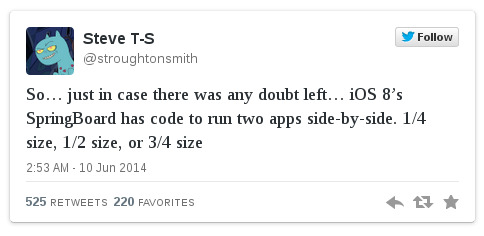iOS 8 split-screen feature lurks in SpringBoard code
One of iOS 8's rumored features obviously didn't make it to the WWDC event. However, if these series of tweets from app developer Steven Troughton-Smith are accurate, the code for the functionality already exists in iOS 8 SpringBoard, which is the other name that the Home Screen is going with.
Split screen multitasking on mobile devices is still a rather contentious subject matter, but major players in the field have somewhat come to such an unspoken agreement on their own. Samsung has one and so does its rival LG. Windows 8, in both full and RT forms, unsurprisingly has those as well. It is then perhaps not surprising to hear of Apple following suite, though purists and true believers might not exactly agree with the new direction.

The feature, however, was left out from the unveiling at WWDC, the primary reason being given is that it just wasn't ready yet. However, the code is already there and just needs some finish. Steve T-S claims that there is code in SpringBoard, particularly under the SBDisplayLayout and related classes, that allows for two apps to share the same screen in 1/4, 1/2, and 3/4 configurations. This is somewhat akin to Windows 8, which initially enforced fixed proportions, only to later backtrack and allow users to split sizes as they see fit.
The existence of the code, however, has little to say about actual implementation. That is, aside from the fact that two apps in a split screen sharing arrangement will only appear as a single screen in the App Switcher, at least according to Steve T-S again. There is no clue on how these pairings are created, though the concept (read: not real) video below seems to be the crowd favorite.
Fans of this style of multitasking still have hope that this too will come to pass. Again according to rumors, the functionality is still undergoing a round of polish before iOS 8 itself is released later this year. However, those same rumors might lead to despair for some, as the split screen feature is believed to ignore the iPad mini and land on the iPad Air exclusively.
